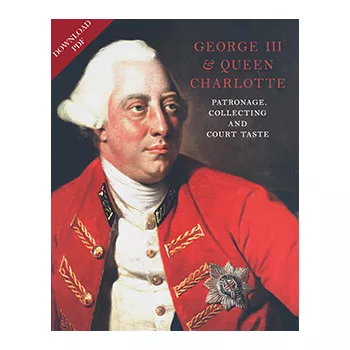Queen Charlotte's Lever Watch and Pedestal 1770
Gold watch case with enamel dial In tortoiseshell and gilt bronze plinth | 10.0 x 8.6 x 8.6 cm (whole object) | RCIN 63759
-
Because it incorporates the earliest known example of the lever escapement this unique watch has been described as ‘perhaps the most historically important watch in the world’. With the exception of the balance spring, this was the greatest single improvement that has ever been applied to watches. As such, this watch is the forerunner of almost all modern wrist and pocket watches. In addition this was the first pocket watch to have an automatic device for compensating changes in temperature.
Thomas Mudge invented the lever escapement in 1754 but this watch, made in 1770, appears to have been the first one to incorporate this important innovation. It was probably acquired by George III for Queen Charlotte: it was referred to as the ‘Queen’s watch’ in correspondence between Mudge and his patron Count von Bruhl, Saxon Ambassador to Great Britain, when it had been returned to Mudge's Plymouth workshop for alterations and adjustment in the early 1770s. Mudge subsequently described his invention as ‘the most perfect watch that can be worn in the pocket, that was ever made’.
Thomas Mudge was born in Exeter in 1715, the second son of the Revd Zachariah Mudge. As a young man Thomas was apprenticed to the celebrated clock, watch and instrument maker George Graham, in the Clockmakers' Company, London. In 1738, Thomas Mudge became a Freeman in the Company. In 1750, just before his former master's death, Mudge opened a business in his own right at the 'Dial and One Crown' in Fleet Street and four years late took Matthew Dutton, another of Graham's apprentices, into partnership.
It is not clear when the plinth was acquired. Signs of alteration suggest that it may not have been made originally for the watch. The first reference to the plinth is in 1825 when the watch was repaired and the plinth overhauled by B.L. Vulliamy for George IV. The watch may have joined the ‘twenty-five watches, all highly adorn’d with jewels’ noticed by Mrs Lybbe Powys in a case beside the Queen’s bed at Buckingham House in 1767.
Backplate signed Tho Mudge / London. Gold case struck with London hallmarks for 1769-70 and maker’s mark PM probably Peter Mounier of Frith Street.
Catalogue entry adapted from George III & Queen Charlotte: Patronage, Collecting and Court Taste, London, 2004Provenance
Probably acquired by George III for Queen Charlotte in 1770
-
Creator(s)
(clockmaker (movement))(clockmaker (case))Acquirer(s)
-
Medium and techniques
Gold watch case with enamel dial In tortoiseshell and gilt bronze plinth
Measurements
10.0 x 8.6 x 8.6 cm (whole object)
3.0 x 6.0 x 6.0 cm (alternative measurement)











